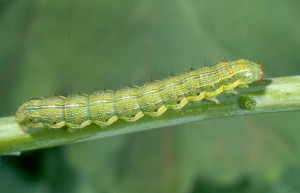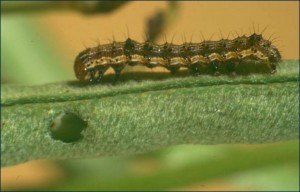Two species of Helicoverpa are serious pests of field crops (particularly grain legumes, summer grains and cotton) in the northern grains region of Australia.
- Helicoverpa armigera (cotton bollworm or corn earworm) is generally regarded as the more serious pest because of its greater capacity to develop resistance to insecticides, broader host range, and persistence in cropping areas from year to year.
- Helicoverpa punctigera (native budworm) numbers in cropping regions fluctuate based on conditions in inland breeding areas.
See also Helicoverpa in specific crops:
Identification
- Eggs are 0.5 mm in diameter and change from white to brown to a black head stage before hatching.
- Newly hatched larvae are light in colour with tiny dark spots and dark heads. As larvae develop they become darker and the darker spots become more obvious. Both species look the same at the egg and small larvae stages.
- Medium larvae develop lines and bands running the length of the body and are variable in colour. H. armigera have a saddle of darker pigment on the fourth segment and at the back of the head and dark-coloured legs. H. punctigera have no saddle and light-coloured legs.
- Large larvae of H. armigera have white hairs around the head; H. punctigera have black hairs around the head.
- Pupae are found in soil underneath the crop. Healthy pupae wriggle strongly when touched. H armigera pupal tail spines are more widely spaced than those of H. punctigera
- Moths are a dull light brown with dark markings and are 35 mm long. H. armigera has a small light or pale patch in the dark section of the hindwing while the dark section is uniform in H. punctigera. Forewings are brown in the female and cream in the male.
Similar species
Commonly confused species include armyworms and loopers. Helicoverpa larvae have a group of four pairs of ´legs´(prolegs) in the back half of the body while loopers can have a group of two, three or four pairs of legs at the rear and loop when walking. Armyworm also have 4 pairs of prolegs, but are smoother and fatter, with more coloured bands than Helicoverpa.
Life cycle
Both species take about 4-6 weeks to develop from egg to adult in summer, and 8-12 weeks in spring or autumn. Moths live for around 10 days during which females can lay 1000 eggs.
View diagrams for:
- Helicoverpa armigera life cycle
- Helicoverpa punctigera life cycle (Northern Region)
- Native budworm life cycle (Southern Region)
Crops attacked
The two species prefer different hosts:
- H. punctigera attacks broadleaf species (e.g. cotton, chickpea, sunflower, soybean, mungbean, navy bean, lucerne, canola, peanut, faba bean, safflower, linseed and azuki bean). It is not found on grass or cereal crops, such as wheat, barley, sorghum or maize.
- H. armigera will attack all field crops, but is less common in wheat and barley.
Larvae feed on leaves but are most damaging when feeding on growing terminals, buds or squares, flowers, pods, seed and/or fruit. This includes direct losses through shedding and reduced quality.
Monitoring and management
Helicoverpa can be present in crops from the vegetative stage onwards. Very susceptible crops (e.g. cotton) need to be closely monitored from emergence to maturity for eggs and larvae, however, most field crops only need to be monitored closely from budding/flowering through to maturity. Eggs are most commonly laid on the top third of the plant and growing points.
To manage H. armigera and H. punctigera well, it is important to understand the basic differences between the two species. IPM strategies incorporating chemical, cultural and biological methods aim to restrict populations to below damaging levels.
H. armigera has developed resistance to a wide range of insecticides, however a number of products are now registered for both species that have reduced impacts on natural enemies in the crop. Larvae are best targeted when smaller than 7 mm.
All stages of the Helicoverpa lifecycle are attacked by a wide range of predators, parasitoids and pathogens, and conserving these in the crop through the avoidance of broad-spectrum insecticides can help prevent/minimise the need for insecticide treatments.
Further information
- Management and economic thresholds for native budworm (Agriculture WA)
- The Beatsheet (select helicoverpa)
- Native budworm (cesar)
- Helicoverpa species and Helicoverpa in winter cereals (DAF Queensland)
- Native budworm (DEPI Victoria)


